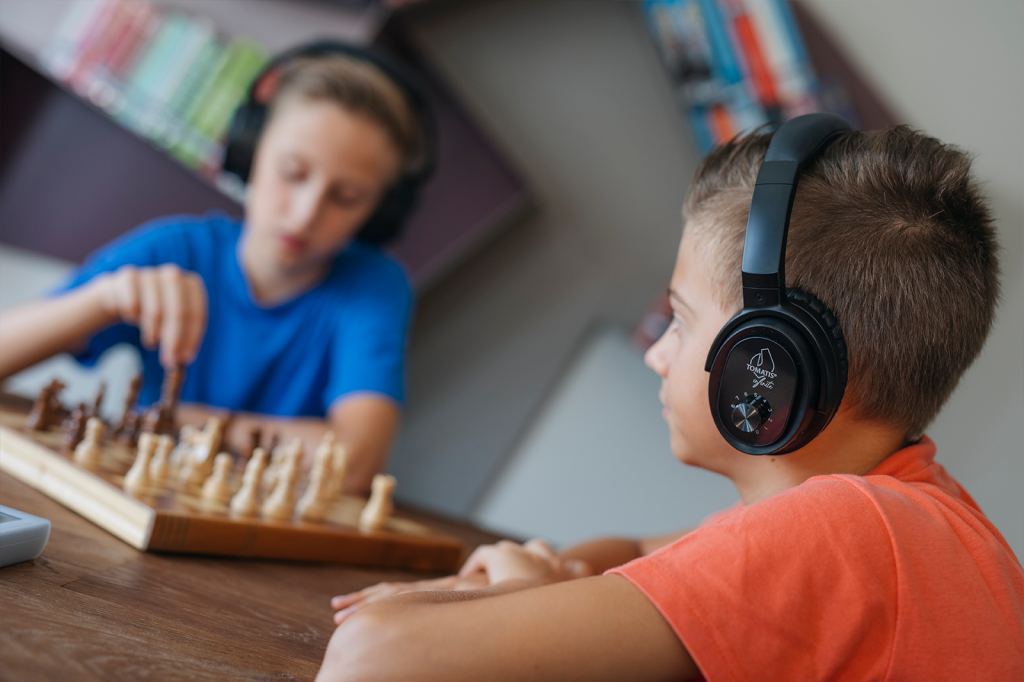
The Tomatis® Method is a natural approach to neurosensory stimulation. Its listening programs change the music and voice in real-time in order to capture the brain’s attention and develop motor, emotional and cognitive skills. Developed by the French Doctor and Researcher, Alfred Tomatis, the Tomatis® Method relies on advanced technology and the excellence of its trained professionals on how to use it.

The Tomatis® Method operates through a single handheld device called TalksUp®. It has been specifically designed to treat music and the voice based on specific parameters. This tool has many features including “Electronic Gating®”. The switch is a unique non-invasive procedure that allows sound contrasts with the sudden transition from low frequency to high frequencies. This back and forth between low and high frequencies causes a major effort of adjustment from the ear and creates a stimulation of the brain.
“One sings – or one speaks – with one’s ear.”
– Dr. Alfred Tomatis –

1. Attention: The process of aiding the brain in developing adaptive mechanisms is crucial. Attention, defined as the ability to focus on external events or thoughts, is vital for maintaining awareness during wakefulness and vigilance. It allows the nervous system to be receptive to incoming information. Attention disorders, affecting both children and adults, manifest as an inability to sustain focus. One specific aspect of attention involves dividing one’s focus among multiple stimuli. Attention deficits have wide-ranging impacts on cognitive functions, incurring cognitive costs and posing challenges in educational settings for children. The Tomatis® procedure utilizes ‘Electronic Gating®,’ introducing a perceptual sound contrast to consistently surprise the brain, promoting alertness and attentiveness. The ultimate objective is to facilitate the development of automatic mechanisms within the brain, enhancing its ability to detect changes and thereby strengthening selective attention. This approach aims to alleviate the cognitive challenges associated with attention deficiencies, providing a potential solution for individuals in educational environments.
2. Dynamism: Energizing the cortex is achieved through ear stimulation, given that over 80% of sensory input originates from the ear. The ear consistently sends stimuli to the brain, playing a crucial role whether one is awake or asleep. Beginning in the fourth month of pregnancy, the ear becomes the first fully functional organ in the fetus. The Cochlea, the human ear, is responsible for “cortical energizing,” requiring stimulation to enhance both brain and body vitality. Sound, particularly rich in high-frequency harmonics, is essential for personal fulfillment. Such sounds activate the “reticular formation,” a neural network governing overall brain activity. Tomatis primarily employs Mozart’s violin concertos, known for their beneficial effects, as they stimulate this neural network effectively.
3. Language: The Tomatis® Method focuses on activating the auditory feedback loop, which plays a crucial role in how emotions can affect your voice. When overwhelmed by emotion, it takes a few seconds to restore your normal voice because the auditory feedback loop is disrupted. This means that your brain struggles to analyze the sounds of your voice accurately. The fundamental principle of the Tomatis® Method is that any influence on the reception and analysis mechanisms of an acoustic message affects how that message is reproduced.
The audio-vocal loop, essential for proper functioning, relies on auditory discrimination, phonological awareness, and rhythm integration, which are natural skills inherent in human function and extend beyond speech to all learning processes. The Tomatis® Method significantly influences the auditory feedback loop during active sessions. Participants listen to their own voice, modulated through “Electronic Gating,” which is activated based on voice intensity and frequency, emphasizing high frequencies crucial for language acquisition. This modulation challenges the brain, promoting adaptation and enhanced integration of patterns and rhythm in one’s own voice.
4. Motor skills & balance: Maximizing the potential of the vestibular system involves recognizing that the ear, beyond its role in sound reception, is crucial for balance, rhythm, and coordination. Blocking one ear while walking illustrates a significant loss of balance, highlighting the ear’s involvement in controlling posture.
Balance is intricately linked to the vestibule, a component of the inner ear that informs the brain about even the slightest body movements. The Tomatis Method influences the vestibule, aiding the body in restoring verticality by repositioning the skeleton. Through sustained listening sessions, synchronization occurs in the messages sent to the brain via the vestibule of both ears. This synchronization results in more coordinated and fluid motor responses, reducing instances of uncoordinated movement. Consequently, the Tomatis® Method demonstrates positive effects on motor disorders. Additionally, the vestibule’s complex network of connections to the brain underscores its fundamental role in integrating the rhythms of both music and language, further contributing to the method’s beneficial effects.
Additional resources and information:
– https://www.tomatis.com/
– https://www.tomatis.com/en/research-and-resources
Tel: (65) 8298 4508
Email: sproutandsprint@gmail.com
Biz Reg Number: UEN 53464972J

DIRFloortime® Practitioner
Denise is a DIRFloortime® Practitioner (DIR-Basic) with a specialization in Sensory Integration and Developmental Play. Her approach combines the DIRFloortime methodology with developmental play strategies and sensory integration techniques. Denise holds a Bachelor’s degree with honors in Psychology from the University of Sussex.
With years of experience, Denise has worked extensively with individuals on the autism spectrum, those with sensory processing difficulties, and learning challenges. She is deeply committed to seeing beyond the surface and believes in the inherent potential of every child, embracing the philosophy, “If a child could, they would.”
Denise has furthered her expertise through various courses, including those from the Maude Le Roux Academy, Developmental Play by CreateCatt, and other programs focused on learning challenges, sensory, play, and emotional processes.

Advisory Partner
Maude Le Roux is an occupational therapist with an extensive following of professionals across the globe. She studies human development in different capacities of growth, spanning ages and stages, neuroanatomy, assessment tools as well as current trends of intervention. She completed her DIR/Floortime® certificate in 2005 and has been an Expert Training Leader for ICDL since 2011. She owns and directs a clinical practice in Glen Mills, PA, where she has become known for her effective assessment and intervention protocol. While she trains globally, Maude continues to operate this active practice to continue to inform her work and develop the case studies from which she expands her assessment and intervention protocol. She co-authored the book “Our Greatest Allies” in 2011 with Lauren O’Malley describing the journey of one child and also describing the DIR/Floortime® Method.

Training Director
James Ho is a certified DIR® Advanced Trainer and specializes in Sensory Integration. He combines the approach of DIR Floortime and play as well as the practice of Sensory Integration as a basis of his work as he strongly believes that learning happens best when the child is having fun. James is also a certified Tomatis Consultant. James graduated from Murdoch University with a Bachelor’s in Psychology and has over 10 years of experience working with children, teens, and adults on the Autism Spectrum as well as those with sensory processing challenges and learning challenges and difficulties. His passion and drive had allowed him to be chosen to manage and coordinate a branch in Jakarta, where he would supervise and train a team of staff. His responsibility also includes conducting reviews with parents and working with them through coaching and giving them advice on parents’ engagement in supporting the child’s ability to partake in his or her learning environment. James is trained and mentored under international trainer, Maude Le Roux, OTR/L, SIPT, RCTC, who is a DIR® Expert Trainer, Certified Tomatis Practitioner, and a consultant. He has also attended various courses with Maude Le Roux Academy. James has attended workshops in understanding the mental health developmental structures as they relate to playing and emotional processes.